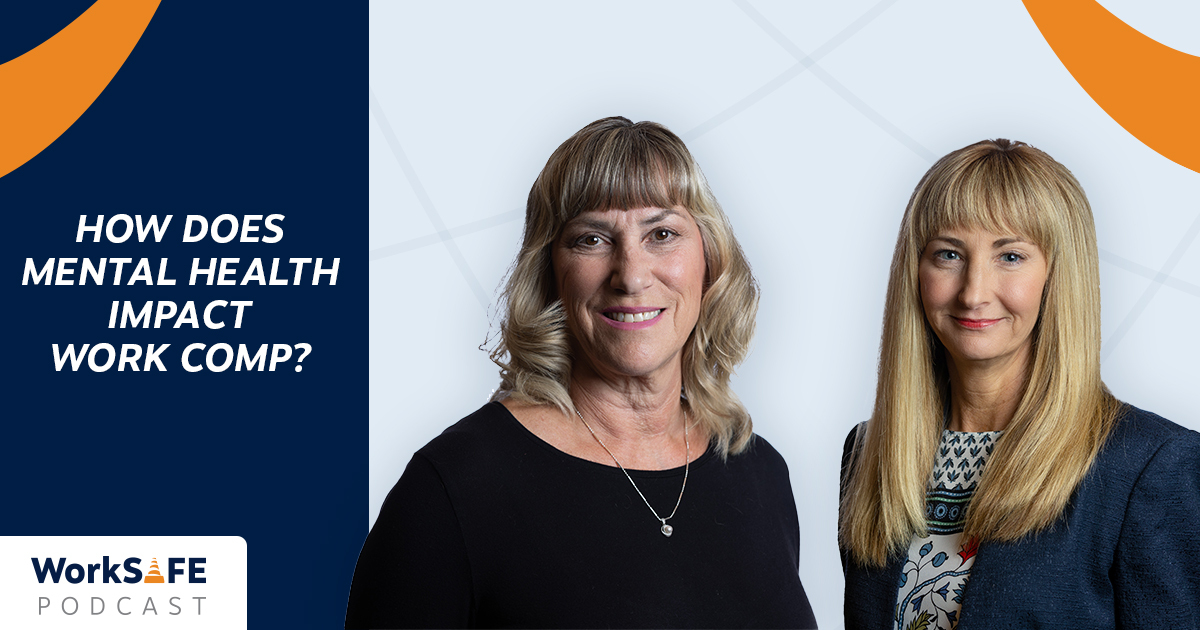Mental health and work comp claims are often tightly intertwined. Many people think only of the physical side of a claim: the injury, the doctor’s visits, the rehabilitation. But an injured worker’s mental health can actually become a documented part of a claim. It’s an element employers should keep in mind not just before a claim, but after.
On this episode of the WorkSAFE Podcast, we sit down with Vickie Egan. She is the Case Management Services Supervisor at Missouri Employers Mutual. Egan has been with the company for six years and has more than 32 years of experience in the nursing field.
First, we’ll talk about two ways mental health plays a role in work comp claims. Then, we’ll explain how mental health issues are addressed and treated. Finally, we’ll discuss the growing role of mental health in the healthcare and return to work processes.
Listen to this episode of the WorkSAFE Podcast or read the show notes below.
Mental health claims: Physical vs. mental injury
When it comes to claims, every injured worker is unique. Their health history, workplace experience, and personal life all play a role in their mental health status. According to Egan, there are two ways mental health comes into play during a claim:
- Physical injury claims. In these situations, a worker has a physical injury. Factors like their injury type and the length of their recovery period may impact their mental health. Treatment is part of the overall claim.
- Mental injury claims. In these situations, a worker experiences mental issues from a workplace environment or experience. This is common for those who witness an incident or experience one without being physically injured.
Mental injuries often slip under the radar. For example, involvement in motor vehicle accidents can have a lingering impact, such as anxiety and trouble concentrating. “There’s a lot of post traumatic stress disorder (PTSD) that we see in those type of situations,” Egan explained. “That’s something that we need to treat. It doesn’t have to be a physical injury.”
Not every worker facing injury encounters mental health issues. For some, a workplace injury causes little mental impact. For others, it’s a tipping point.
What does the recovery process look like?
Recovering from a mental health issue is different for everyone. Unlike a physical injury – for example, a broken bone or sprained ankle – determining what is needed to heal is done on a case-by-case basis.
Nurse Case Managers (NCMs) watch closely for behavior or dialogue that may indicate a mental health claim is needed. For instance, changes in attitude, morale, or productivity at work. Employees may turn up late, call in sick more often, or act in unusual ways.
Sometimes employers are the first ones to catch and report these indicators. In other situations, medical providers may be the ones to raise concerns. “There’s a lot of information that can come from different sources,” Egan shared. First, NCMs engage with the worker. Then, they connect with the medical provider. What they learn determines the next step; the need for a psychologist, a psychiatrist, a counselor, or any combination of these.
Step-by-step treatment
After an initial evaluation, injured workers are often authorized to receive six treatment sessions. This allows a mental health professional to better assess their needs and create an updated care plan. If the injured worker needs more help, then more sessions are authorized.
For Egan, it’s important to help the provider understand the goal of returning to work. This includes explaining the demands of the job and potential accommodations for a mental injury.
“That’s kind of an interesting work status to have worked out,” she said. “Sometimes it does take some dialogue with both a policyholder and with the provider to try to get a work status that clarifies things and that people can follow, and help that process of return to work go smoothly and successfully.”
Resistance to treatment
Not all injured workers dealing with mental health claims are accepting of treatment. The stigma around receiving mental health assistance exists. Although social media and accessibility to care has broken down some barriers, workers of certain ages or industries still resist.
For Egan, an employer’s priorities around mental health should be to educate, support, and encourage. Employees should know what mental health services are available to them. They should also know that these services have been put in place to support them, and that trying to receive help at least once is better than not trying at all. Although some may reject the idea at first, it is worth circling back to the topic – their attitude may change over time.
Mental health claims: Part of the healthcare process
Mental health is more integrated into the healthcare process than ever before. From an emergency room visit to a regular check-up, providers are asking more questions about lifestyle, safety, and emotional stability. “There’s those questions that are part of every assessment now,” Egan shared. “I don’t recall that being there in my many earlier years of working as a nurse, so it is in the forefront. It’s part of the process.”
Attitudes around mental health continue to evolve. Decades ago, admitting to a mental health issue was considered shameful. Now, assessing a patient’s state of mind is an active part of providing treatment. “We want to see it,” she added. Mental health issues no longer hide in the shadows. “We want to address it. We want to make that part of the care.”
Preparing to return to the workplace
Returning to the workplace looks different for every injured employee. They may need modified duty, adjusted work hours, or alternative work while they recover. The same approach applies to mental injury.
“It’s different for everybody,” Egan explained. “That’s where we have to really lean on on the professionals to help us through this.” MEM utilizes a partner to help identify source the right mental health providers. This extends to connecting them with injured workers in the best way, whether that be over the phone or in person.
Taking a proactive approach to mental health on the job
Not every employer can afford an employee-based mental health program. But showing support, offering resources, and being attentive to employees’ well-being is a great way to start. Talking to work comp carriers about concerns and the resources they can provide is also a great way to stay informed. This way, employers have knowledge of what is available in the event of a mental health claim. For example, telehealth has opened the door to provider access – especially for those hesitant to visit an office.
Mental health matters
When it comes to work comp claims, we often think that clearing an injured worker for the job physically is the priority. However, being mentally fit to return to the workplace is essential. Employees must have good situational awareness and be attentive on the job. This not only help ensure their safety, but the safety of those working with them.
“It’s important to remember that work has such a significant impact on an individual,” Egan finished. “It’s how they define themselves. Many times, it is a big part of their life and it gives them purpose.” Experiencing a workplace injury, or even exposure to an incident, can take much of that away. Employees may experience depression, stress, anxiety, and PTSD as a result. “These are real diagnoses and these are things that we just can’t overlook anymore in the process of recovery.”



